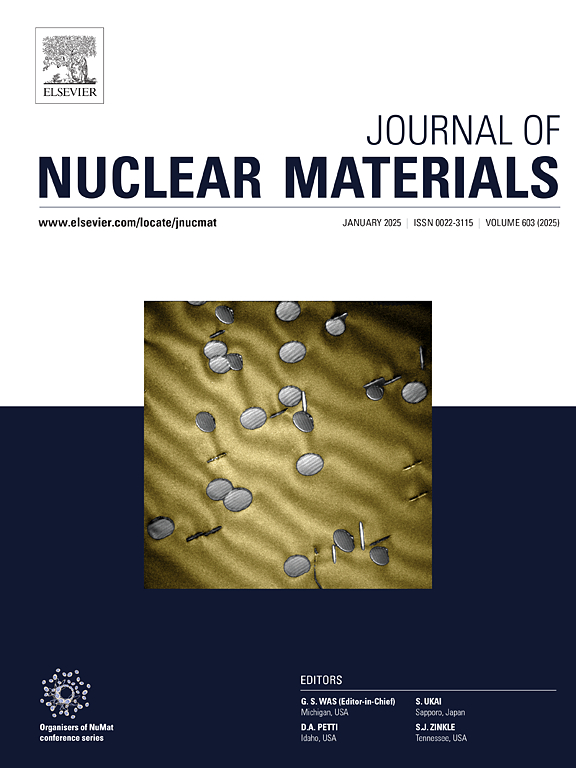Scalable fabrication and deuterium release properties of Li2TiO3-Li2ZrO3 ceramic pebbles via centrifugal granulation
IF 3.2
2区 工程技术
Q3 MATERIALS SCIENCE, MULTIDISCIPLINARY
引用次数: 0
Abstract
The Li2TiO3 and Li2ZrO3 ceramic pebbles are regarded as promising tritium breeder on account of their superb chemical stability, high tritium diffusion rates, and neutron multiplication potential of Zr, respectively. To integrate the advantages of these two materials, it is necessary to develop a composite such as Li2TiO3-Li2ZrO3, which is ideal for advanced fusion reactor designs. Up to now, fabricated biphasic ceramic pebbles generally suffer from low production yield, inadequate crushing load, and high cost, which restricts their application in practice. In this paper, biphasic Li2TiO3-Li2ZrO3 tritium breeding pebbles with superior crushing strength are successfully fabricated employing the centrifugal granulation method by selecting the appropriate binder and controlling the growth rate. Moreover, by this technique, ceramic pebbles with wide diameter distribution can be obtained, which will help to improve the packing factor of pebble beds in the solid blanket. In addition, the composition, microstructure, and internal structure of the Li2TiO3-Li2ZrO3 ceramic pebbles are thoroughly analyzed, respectively. The Li2TiO3-Li2ZrO3 ceramic pebbles, after being sintered at 1100 °C, attained a high sphericity of 0.97, a superior crushing load of 67.6 N, and an optimum porosity of 9.75 % in the shell. Moreover, the Li2TiO3-Li2ZrO3 ceramic pebbles also exhibit excellent deuterium release properties with the main form of HDO. The above results show that the centrifugal granulation method is not only applicable to the mass production of Li2TiO3-Li2ZrO3 ceramic pebbles but also to other tritium breeders, which offers promising prospects for the development of advanced tritium breeding materials in the future.
离心造粒法制备Li2TiO3-Li2ZrO3陶瓷卵石及其氘释放性能
Li2TiO3和Li2ZrO3陶瓷卵石分别具有优异的化学稳定性、较高的氚扩散速率和Zr的中子增殖势,被认为是很有前途的氚增殖材料。为了整合这两种材料的优点,有必要开发Li2TiO3-Li2ZrO3等复合材料,这是先进聚变反应堆设计的理想选择。目前,制备的双相陶瓷卵石普遍存在产量低、破碎载荷不足、成本高等问题,制约了其实际应用。本文通过选择合适的粘结剂和控制生长速率,采用离心造粒法成功制备了具有优异破碎强度的Li2TiO3-Li2ZrO3两相氚孕育卵石。此外,利用该技术可以获得直径分布较宽的陶瓷卵石,这将有助于提高固体毯层中卵石层的填充系数。此外,还对Li2TiO3-Li2ZrO3陶瓷卵石的组成、微观结构和内部结构进行了深入分析。经1100℃烧结制备的Li2TiO3-Li2ZrO3陶瓷卵石,球度为0.97,破碎载荷为67.6 N,壳层孔隙率为9.75%。此外,Li2TiO3-Li2ZrO3陶瓷卵石也表现出优异的氘释放性能,其主要形式为HDO。以上结果表明,离心造粒法不仅适用于Li2TiO3-Li2ZrO3陶瓷卵石的批量生产,也适用于其他氚育种材料,为未来先进氚育种材料的开发提供了广阔的前景。
本文章由计算机程序翻译,如有差异,请以英文原文为准。
求助全文
约1分钟内获得全文
求助全文
来源期刊

Journal of Nuclear Materials
工程技术-材料科学:综合
CiteScore
5.70
自引率
25.80%
发文量
601
审稿时长
63 days
期刊介绍:
The Journal of Nuclear Materials publishes high quality papers in materials research for nuclear applications, primarily fission reactors, fusion reactors, and similar environments including radiation areas of charged particle accelerators. Both original research and critical review papers covering experimental, theoretical, and computational aspects of either fundamental or applied nature are welcome.
The breadth of the field is such that a wide range of processes and properties in the field of materials science and engineering is of interest to the readership, spanning atom-scale processes, microstructures, thermodynamics, mechanical properties, physical properties, and corrosion, for example.
Topics covered by JNM
Fission reactor materials, including fuels, cladding, core structures, pressure vessels, coolant interactions with materials, moderator and control components, fission product behavior.
Materials aspects of the entire fuel cycle.
Materials aspects of the actinides and their compounds.
Performance of nuclear waste materials; materials aspects of the immobilization of wastes.
Fusion reactor materials, including first walls, blankets, insulators and magnets.
Neutron and charged particle radiation effects in materials, including defects, transmutations, microstructures, phase changes and macroscopic properties.
Interaction of plasmas, ion beams, electron beams and electromagnetic radiation with materials relevant to nuclear systems.
 求助内容:
求助内容: 应助结果提醒方式:
应助结果提醒方式:


